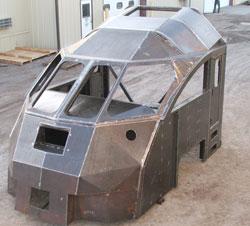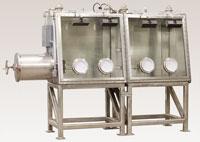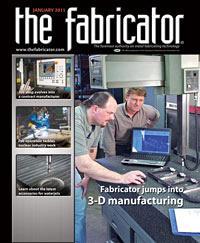Senior Editor
- FMA
- The Fabricator
- FABTECH
- Canadian Metalworking
Categories
- Additive Manufacturing
- Aluminum Welding
- Arc Welding
- Assembly and Joining
- Automation and Robotics
- Bending and Forming
- Consumables
- Cutting and Weld Prep
- Electric Vehicles
- En Español
- Finishing
- Hydroforming
- Laser Cutting
- Laser Welding
- Machining
- Manufacturing Software
- Materials Handling
- Metals/Materials
- Oxyfuel Cutting
- Plasma Cutting
- Power Tools
- Punching and Other Holemaking
- Roll Forming
- Safety
- Sawing
- Shearing
- Shop Management
- Testing and Measuring
- Tube and Pipe Fabrication
- Tube and Pipe Production
- Waterjet Cutting
Industry Directory
Webcasts
Podcasts
FAB 40
Advertise
Subscribe
Account Login
Search
Fabricator touts precision production
Demanding niche spurs growth through recession
- By Tim Heston
- August 1, 2011
- Article
- Shop Management
Walk the 60,000 square feet of manufacturing space within a 5-acre campus in Idaho, just off the highway that eventually winds into Grand Teton National Park, and you can see not only how Diversified Metal Products is, well, diversified, but also how shop managers have carved a unique niche in precision work.
One area processes stainless steel, mainly fabricated for critical applications in the nuclear industry. Metal is tested to ensure it meets strict standards, including the ASME NQA-1 (Nuclear Quality Assurance) specification. Welders are certified to the AWS D1.1 and, because the company does a lot of pressure vessel work, the ASME Section IX Boiler and Pressure Vessel Code, as well as to the National Board of Boiler and Pressure Vessel Inspectors.
If a job calls for 6-mm-thick stainless steel, 0.25 in. won’t do. It must be 6 mm; a sheet with a few extra ten-thousandths of an inch thickness would throw everything off. Some work requires that customers witness the first article being fabricated. Many jobs require that raw stock be chemically tested to ensure the makeup and consistency are what they should be. And much of the shop’s nuclear work must undergo 100 percent weld inspection using die penetrant, magnetic particle, radiography, or other nondestructive techniques.
The shop maintains tight tolerances on large fabrications. One glovebox for the nuclear industry (see Figure 1), for instance, consists of plate bent into a U channel, cut at 45 degrees, and then welded on four corners. “It’s about 3 feet by 3 feet,” said Dan Payne, business development manager, “and we have to hold it within a 1⁄32 in. tolerance.”
On the other side of the plant sits a cab for a light-rail commuter train (see Figure 2). Half-inch-thick square tubing is bent in an arc to form the front of the cab, and components making up the cab’s opening in the back must be kept within 1⁄16 in.—and this is for a large train cab, not a small, precision component.
The shop employs 87, and employee head count has increased consistently even during the downturn. “We’ve averaged about 20 percent growth for each of the past five years,” Payne said. At this writing, the company was on pace to repeat that growth for 2010, and managers expect similar expansion for 2011. The shop has orders booked for the first and second quarters of this year. These days many would kill for such a backlog.
In September the shop won an $8.5 million contract from Shaw AREVA MOX Services for work to be performed for the Mixed Oxide Fuel Fabrication Facility at the Department of Energy’s Savannah River Site in Aiken, S.C. In fact, DMP has been doing business connected to the DOE for more than two decades. The nearby Idaho National Laboratory, a major DOE research facility, is a major customer.
How has the shop achieved such a track record? At first it seems obvious: 80 to 90 percent of revenue comes from government-related work. There was a reason why back in 1988 company founders decided to set up shop in Idaho Falls, Idaho, with Idaho National Lab just a few blocks away. Ever since, contracts for the lab and other DOE facilities have made up a good portion of DMP’s work. It also helped fill shortfalls in other sectors during the downturn.
For instance, about six years ago the shop did significant work for the food services industry. The state’s iconic potato industry needed processing equipment, and DMP helped fabricate components for them. During the downturn, demand for such equipment plummeted with the rest of the capital equipment market, and orders flowing to DMP slowed to a trickle.
But there’s more behind the shop’s success than its government-related work. For years the company has adapted elements of lean manufacturing to highly specialized fabrication. Such efforts helped the firm grow during tough times, and they also may help meet future demands from customers in established niches, including the nuclear field.

Figure 2: This train cab must be fabricated to precision tolerances, with certain large elements needing to be positioned to within 1⁄16 in.
Some of the company’s so-called “quick-fixturing” tables show a little about the manufacturer’s lean thinking. One-offs represent a large portion of the company’s business, so one might think that setup for welding and other processes would be a bear. But this isn’t always the case, and it’s largely due to those fixturing tables.
Built by the people at DMP, they’re unique and, for competitive reasons, couldn’t be photographed. But roughly speaking, the tables are on wheels, so they can be moved from one station to another as needed. Below each table hangs a variety of clamps and other fixtures. When a part comes into the workcell, a technician chooses a combination of those clamps to fixture it. The tables exemplify how DMP—along with many other high-mix, low-volume operations—adopts lean manufacturing. They find commonalities among disparate parts and develop standard procedures that can be measured and improved upon.
That idea applies to all areas of the manufacturing floor, which is divided into three areas: one dedicated to carbon steel production and two others for stainless steel. Stepping from one area to another can feel like entering a completely different company, especially when visiting the area for that commuter train cab, which operates more like a production facility, less like a high-mix, low-volume job shop. Workers can fabricate about one cab a week. Since starting the contract about three and a half years ago, workers have perfected the process to minimize handling between operations and minimize inventory, including raw stock, work-in-process (WIP), and finished goods.
On the other hand, gloveboxes can take longer to complete. Metal must be sent out for testing, and customer representatives often must witness the first weld and other critical manufacturing steps. It’s carefully planned for good reason. Those gloveboxes protect workers from perhaps the world’s best-known hazardous chemical: plutonium.
This mix of one-off and production fabrication may give the company a leg up in the future, when many predict that, after many years of dormancy, nuclear plant construction will surge again in earnest. “Some of the demands for new construction will be different,” Payne said. “For the DOE work, each product is highly specialized and unique.” Nuclear plant construction, though, “will have repeatable items, and assemblies may be used in several plants rather than one having a unique design.”
The shop offers production, precision, and experience in meeting high quality standards for some of the most demanding industrial sectors. That’s likely to be a sought-after combination in the years ahead.
Photos courtesy of Diversified Metal Products Inc., 3710 N. Yellowstone Hwy., Idaho Falls, ID 83401, 208-529-9655, www.diversifiedmetal.com.
About the Author

Tim Heston
2135 Point Blvd
Elgin, IL 60123
815-381-1314
Tim Heston, The Fabricator's senior editor, has covered the metal fabrication industry since 1998, starting his career at the American Welding Society's Welding Journal. Since then he has covered the full range of metal fabrication processes, from stamping, bending, and cutting to grinding and polishing. He joined The Fabricator's staff in October 2007.
subscribe now

The Fabricator is North America's leading magazine for the metal forming and fabricating industry. The magazine delivers the news, technical articles, and case histories that enable fabricators to do their jobs more efficiently. The Fabricator has served the industry since 1970.
start your free subscription- Stay connected from anywhere

Easily access valuable industry resources now with full access to the digital edition of The Fabricator.

Easily access valuable industry resources now with full access to the digital edition of The Welder.

Easily access valuable industry resources now with full access to the digital edition of The Tube and Pipe Journal.
- Podcasting
- Podcast:
- The Fabricator Podcast
- Published:
- 04/16/2024
- Running Time:
- 63:29
In this episode of The Fabricator Podcast, Caleb Chamberlain, co-founder and CEO of OSH Cut, discusses his company’s...
- Industry Events
16th Annual Safety Conference
- April 30 - May 1, 2024
- Elgin,
Pipe and Tube Conference
- May 21 - 22, 2024
- Omaha, NE
World-Class Roll Forming Workshop
- June 5 - 6, 2024
- Louisville, KY
Advanced Laser Application Workshop
- June 25 - 27, 2024
- Novi, MI
































